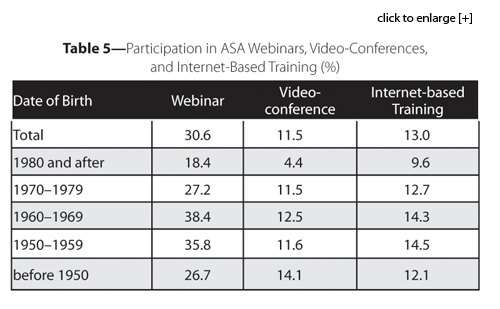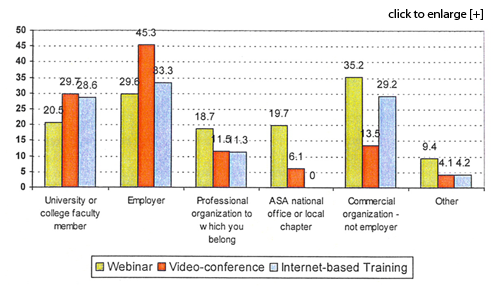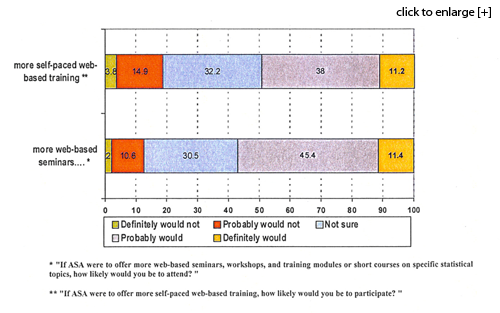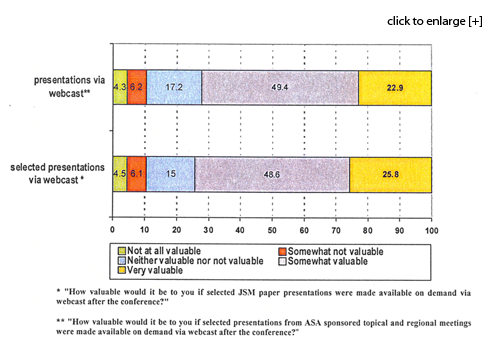ASA Meetings Survey Results
Chapter and Regional Meetings
ASA extends its membership reach through chapter and regional activities. Approximately 68% of respondents believe they have a chapter in their area of residence (~20% don’t know—suggesting an awareness campaign might be worthwhile), and about 73% of these are members of their local chapter, and more respondents are male (75%) than female (68%), and they tend to be longer-term members. Despite being chapter members, most (56%) do not participate regularly in chapter activities, not because chapters are poorly organized but rather because either the location or time are inconvenient or the activities are not interesting to them. Among the most important reasons for participation in chapters are social networking, educational and professional development, and acquiring or sharing knowledge.
As for regional meetings, roughly 62% of respondents do not regularly participate in activities in their geographic area, with a sizable proportion (31%) unaware of regional events (again, suggesting either promoting more activities or awareness or incentive campaigns when in fact regional activities are offered). Almost 53% probably or definitely would attend conferences, workshops, or training opportunities in their region, and 65% think the ASA should do more to promote these types of events.
Webinars, Videoconferences, and Internet
We focus next on alternative media activities supported by ASA: webinars, videoconferences, and Internet-based training.
Participation
Respondents were asked whether they have participated in any webinar, videoconference, or Internet-based training on a statistically-related topic in the past 12 months. Among these modes, webinars were the most often attended, albeit by only 30.6%, while videoconferences and Internet-based training were attended by 11.5% and 13%, respectively.
Webinar participation by age revealed significant variation (Table 5): Younger and older responders do not appear to participate as much as other age groups. Creating content that would entice the younger ASA members would perhaps prove fruitful. Participation in videoconferences and Internet-based training across age groups did not significantly vary.
Participation variations across gender and across geography were also not statistically significant, with the exception of webinars, which appear to be more popular in the United States (33.5%) versus non-U.S. (10.6%).
Organizers
Organizers of webinars, videoconferences, and Internet-based training vary across events sponsored by the ASA. Respondents who participated in any of the three activities were asked whether the organizer was university or college faculty member, employer, professional organization, ASA national office or local chapter, commercial organization (not employer), or other. Most webinar organizers were commercial organizations (not employers; 35.2%), followed by employers (29.6%). As for videoconference organizers, employers ranked highest (45.3%), followed by universities or college faculty members (29.7%). For Internet-based training, organizers were employers (33.3%), commercial organizations (29.2%), and universities or college faculty members (28.6%), in rank order (Figure 4).
If you have participated in any of these please indicate who organized the webinar, video-conference, or self-paced course in which you participated (%):
Ratings
We next asked questions about some types of technology-based meetings or training as well as their use of technology in some activities generally. Respondents were asked to rate different kinds of technology-based meetings or training. More than 80% of the respondents indicated that short seminars by experts on specific statistical topics are valuable or very valuable. Also, almost 80% of the respondents indicated one-day workshops on statistical topics are valuable or very valuable. According to the rating of the self-paced, web-based trainings, ~61% of the respondents indicated that self-paced web-based trainings are valuable or very valuable (Figure 6).
Respondents were then asked if they were willing to attend more web-based seminars, workshops, and training modules or short courses on specific statistical topics. Also, they were asked if they were willing to attend more self-paced, web-based trainings. As indicated in Figure 5, about 38% of the respondents probably would attend more self-paced, web-based seminars, workshops, and training modules or short courses on specific statistical topics (if offered by the ASA), while 11.2% of the respondents indicated that they would definitely attend. About 45.4% of the respondents would probably attend more web-based seminars, while 11.4% of the respondents indicated that they would definitely attend. Generally, 50% to 60% of ASA members would be interested in more of this type of education format.
Making conference presentations available via webcast had a very positive response. As indicated in Figure 6, about 75% indicated that it would be valuable (25.8% very valuable and 48.6% valuable) if selected JSM paper presentations were made available on demand via webcast after the conference. A consistent finding applies for presentations given at topical and thematic meetings (table not included).






















